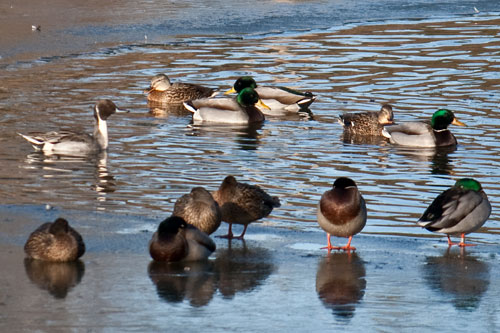 Yesterday afternoon, a beautifully sunny and cold central Ohio day, I stopped at Blendon Woods Metroparks to see what had flown in to Thoreau Lake. There are two great unheated observation buildings at the edge of the lake, and they make bird photography really easy. The building to the right is great for feeder birds, and the left building provides the best opportunities for waterfowl. After scanning the ice free areas of the pond, I could only come up with black ducks, mallards, Canada geese, and two gadwals. But then something caught my eye- a bright white neck. Without binoculars, and without being able to view it with the gigantic metal spotting scope in the building because the bird had positioned itself where it was blocked by the corner support of the building, this bird remained a mystery.
Yesterday afternoon, a beautifully sunny and cold central Ohio day, I stopped at Blendon Woods Metroparks to see what had flown in to Thoreau Lake. There are two great unheated observation buildings at the edge of the lake, and they make bird photography really easy. The building to the right is great for feeder birds, and the left building provides the best opportunities for waterfowl. After scanning the ice free areas of the pond, I could only come up with black ducks, mallards, Canada geese, and two gadwals. But then something caught my eye- a bright white neck. Without binoculars, and without being able to view it with the gigantic metal spotting scope in the building because the bird had positioned itself where it was blocked by the corner support of the building, this bird remained a mystery. In the field, the white belly, brown head, and white neck really stood out. Was it a northern pintail? But it didn't have the typical long pointed butt feathers (technical term please?). Sure enough, after looking at several northern pintail pictures online, I think that is what we have here. But why no long tail? That is the question. Is this a juvenile?
Tom
P.S. This is my 699 post here at the Ohio Nature Blog. Also- We now have 99 followers here. Help me push it over 100!
Tom

Sprig is the technical term. You also have a banded mallard, probably banded on one of the waterfowl production areas in the Great Lakes states. Note that most pintails are produced in the prairies, and largely winter west and south of the Mississippi (I'm thinking Laguna Madre on the TX/Mex border). Nice photo - very few ducks in Maryland yet!
ReplyDeleteIf you're bored - check out my most recent post on the effect of Great Lakes ice on duck migration in the Atlantic flyway.
The pintail looks like it's in adult plumage to me, but I'll admit to knowing very little when it comes to ducks. If I didn't have a very content cat on my lap, I might see if I could dig out our Birds of North America account on the species. :) Ducks, or at least the ones I know, moult after breeding (males mate then abandon the females to go moult; females hatch the chicks then moult while the chicks are also flightless). So it's unlikely that it's moulting. It may simply have had a run-in with something, and the something was only able to catch its long tail as it departed.
ReplyDeleteKirk- Sprig. Interesting. That's a new word for me. Do all ducks have springs, or just the Northern Pintail? Also- I completely missed the banded mallard. Fatherhood has me rushing to get these posts up before the little guy needs us again! I'll check out your post.
ReplyDeleteThanks Seabrooke for your thoughts. Yes, perhaps there's a snapping turtle lurking around somewhere with a featherball in its gut!
Tom
Lovely Pintail!
ReplyDeleteYup - at this point of the fall/winter, all waterfowl are in their adult plumage. The colors may or may not be very bright, but most of them come out of their flightless period by around August 1.
ReplyDeleteTom - nobody else has a "sprig." Depending on what type of bird you're looking at (and the area origin of the "tail" feathers you see), they are called "tail" "upperwing coverts" or "retrices."